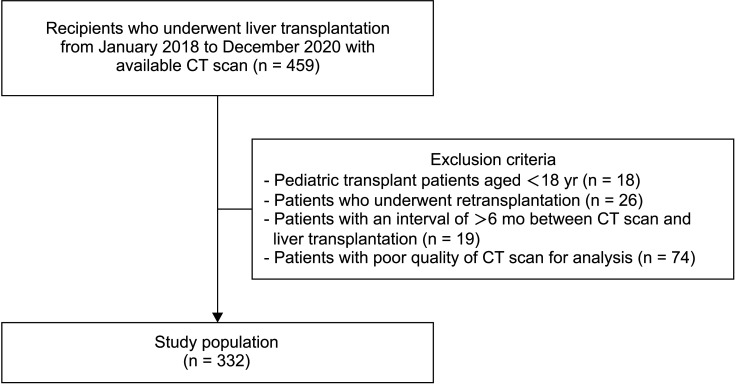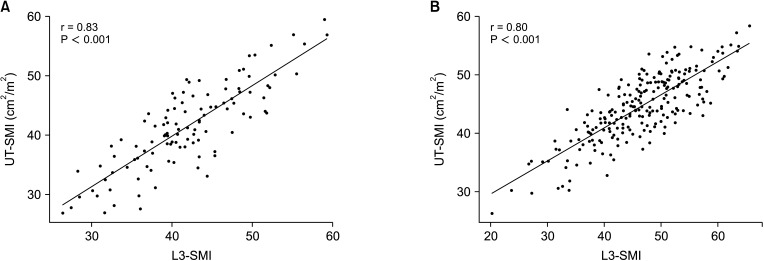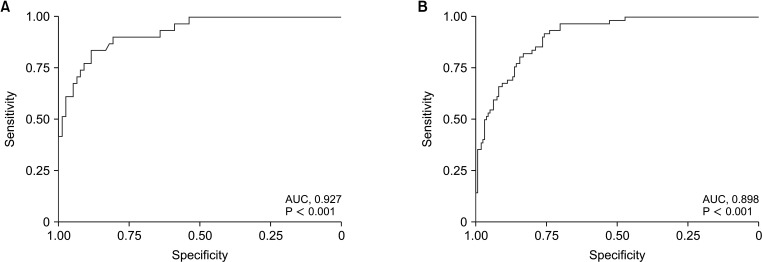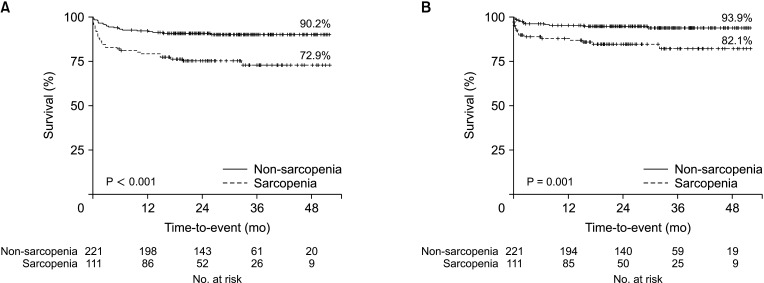Ann Surg Treat Res.
2023 Oct;105(4):219-227. 10.4174/astr.2023.105.4.219.
Upper thigh skeletal muscle index predicts outcomes in liver transplant recipients
- Affiliations
-
- 1Department of Surgery, Samsung Medical Center, Sungkyunkwan University School of Medicine, Seoul, Korea
- 2Department of Surgery, Myongji Hospital, Hanyang University Medical Center, Goyang, Korea
- 3Department of Surgery, Inha University Hospital, Inha University School of Medicine, Incheon, Korea
- 4Department of Surgery, Dongguk University Medical Center, Goyang, Korea
- KMID: 2546784
- DOI: http://doi.org/10.4174/astr.2023.105.4.219
Abstract
- Purpose
The skeletal muscle index (SMI) at the L3 level is widely used to diagnose sarcopenia. The upper thigh (UT) also reflects changes in whole-body muscle mass, but no study has examined this using the UT to diagnose sarcopenia in liver transplantation (LT). This study aimed to determine an optimal cut-off value for UT-SMI and investigate how sarcopenia diagnosed by UT-SMI correlates with outcomes in LT recipients.
Methods
In this retrospective study of 332 LT patients from 2018 to 2020, we investigated the association between sarcopenia diagnosed by UT-SMI and patient outcomes after LT.
Results
The cut-off values for UT-SMI were 38.3 cm 2 /m 2 for females (area under the curve [AUC], 0.927; P < 0.001) and 46.7 cm 2 /m 2 for males (AUC, 0.898; P < 0.001). The prevalence of sarcopenia diagnosed by UT-SMI was 33.4% in our cohort. Patient and graft survival rates in the UT-SMI sarcopenia group were significantly poorer than those in the UT-SMI non-sarcopenia group (P < 0.001 and P < 0.001). UT-SMI was an independent prognostic factor for patient survival (hazard ratio [HR], 2.182; 95% confidence interval [CI], 1.183–4.025; P = 0.012) and graft survival (HR, 2.227; 95% CI, 1.054–4704; P = 0.036) in our multivariable Cox analysis.
Conclusion
We confirmed that sarcopenia diagnosed by UT-SMI is associated with outcomes in LT recipients. In addition, UT-SMI was identified as an independent prognostic factor for patient survival and graft survival. Therefore, UT-SMI could be a good option for CT-based evaluations of sarcopenia in LT recipients.
Keyword
Figure
Reference
-
1. Cruz-Jentoft AJ, Baeyens JP, Bauer JM, Boirie Y, Cederholm T, Landi F, et al. Sarcopenia: European consensus on definition and diagnosis. Report of the European Working Group on Sarcopenia in Older People. Age Ageing. 2010; 39:412–423. PMID: 20392703.2. Anker SD, Morley JE, von Haehling S. Welcome to the ICD-10 code for sarcopenia. J Cachexia Sarcopenia Muscle. 2016; 7:512–514. PMID: 27891296.
Article3. Reisinger KW, van Vugt JL, Tegels JJ, Snijders C, Hulsewé KW, Hoofwijk AG, et al. Functional compromise reflected by sarcopenia, frailty, and nutritional depletion predicts adverse postoperative outcome after colorectal cancer surgery. Ann Surg. 2015; 261:345–352. PMID: 24651133.
Article4. Meza-Junco J, Montano-Loza AJ, Baracos VE, Prado CM, Bain VG, Beaumont C, et al. Sarcopenia as a prognostic index of nutritional status in concurrent cirrhosis and hepatocellular carcinoma. J Clin Gastroenterol. 2013; 47:861–870. PMID: 23751844.
Article5. Oh RK, Ko HM, Lee JE, Lee KH, Kim JY, Kim JS. Clinical impact of sarcopenia in patients with colon cancer undergoing laparoscopic surgery. Ann Surg Treat Res. 2020; 99:153–160. PMID: 32908847.
Article6. Isoyama N, Qureshi AR, Avesani CM, Lindholm B, Bàràny P, Heimbürger O, et al. Comparative associations of muscle mass and muscle strength with mortality in dialysis patients. Clin J Am Soc Nephrol. 2014; 9:1720–1728. PMID: 25074839.
Article7. Dasarathy S, Merli M. Sarcopenia from mechanism to diagnosis and treatment in liver disease. J Hepatol. 2016; 65:1232–1244. PMID: 27515775.
Article8. Tandon P, Ney M, Irwin I, Ma MM, Gramlich L, Bain VG, et al. Severe muscle depletion in patients on the liver transplant wait list: its prevalence and independent prognostic value. Liver Transpl. 2012; 18:1209–1216. PMID: 22740290.
Article9. Esser H, Resch T, Pamminger M, Mutschlechner B, Troppmair J, Riedmann M, et al. Preoperative assessment of muscle mass using computerized tomography scans to predict outcomes following orthotopic liver transplantation. Transplantation. 2019; 103:2506–2514. PMID: 30985737.
Article10. Sim JH, Kwon HM, Kim KW, Ko YS, Jun IG, Kim SH, et al. Associations of sarcopenia with graft failure and mortality in patients undergoing living donor liver transplantation. Liver Transpl. 2022; 28:1345–1355. PMID: 35243771.
Article11. van Vugt JL, Levolger S, de Bruin RW, van Rosmalen J, Metselaar HJ, IJzermans JN. Systematic review and meta-analysis of the impact of computed tomography-assessed skeletal muscle mass on outcome in patients awaiting or undergoing liver transplantation. Am J Transplant. 2016; 16:2277–2292. PMID: 26813115.
Article12. Lee K, Shin Y, Huh J, Sung YS, Lee IS, Yoon KH, et al. Recent issues on body composition imaging for sarcopenia evaluation. Korean J Radiol. 2019; 20:205–217. PMID: 30672160.
Article13. Albano D, Messina C, Vitale J, Sconfienza LM. Imaging of sarcopenia: old evidence and new insights. Eur Radiol. 2020; 30:2199–2208. PMID: 31834509.
Article14. Carey EJ, Lai JC, Sonnenday C, Tapper EB, Tandon P, Duarte-Rojo A, et al. A North American expert opinion statement on sarcopenia in liver transplantation. Hepatology. 2019; 70:1816–1829. PMID: 31220351.
Article15. Durand F, Buyse S, Francoz C, Laouénan C, Bruno O, Belghiti J, et al. Prognostic value of muscle atrophy in cirrhosis using psoas muscle thickness on computed tomography. J Hepatol. 2014; 60:1151–1157. PMID: 24607622.
Article16. Lee SJ, Janssen I, Heymsfield SB, Ross R. Relation between whole-body and regional measures of human skeletal muscle. Am J Clin Nutr. 2004; 80:1215–1221. PMID: 15531668.
Article17. Kara M, Kaymak B, Ata AM, Özkal Ö, Kara Ö, Baki A, et al. STAR-sonographic thigh adjustment ratio: a golden formula for the diagnosis of sarcopenia. Am J Phys Med Rehabil. 2020; 99:902–908. PMID: 32941253.18. Oba H, Matsui Y, Arai H, Watanabe T, Iida H, Mizuno T, et al. Evaluation of muscle quality and quantity for the assessment of sarcopenia using mid-thigh computed tomography: a cohort study. BMC Geriatr. 2021; 21:239. PMID: 33849469.
Article19. Ko Y, Shin Y, Sung YS, Lee J, Lee JH, Kim JK, et al. A reliable and robust method for the upper thigh muscle quantification on computed tomography: toward a quantitative biomarker for sarcopenia. BMC Musculoskelet Disord. 2022; 23:93. PMID: 35086521.
Article20. Nishikawa H, Shiraki M, Hiramatsu A, Moriya K, Hino K, Nishiguchi S. Japan Society of Hepatology guidelines for sarcopenia in liver disease (1st edition): recommendation from the working group for creation of sarcopenia assessment criteria. Hepatol Res. 2016; 46:951–963. PMID: 27481650.
Article21. Carey EJ, Lai JC, Wang CW, Dasarathy S, Lobach I, Montano-Loza AJ, et al. A multicenter study to define sarcopenia in patients with end-stage liver disease. Liver Transpl. 2017; 23:625–633. PMID: 28240805.
Article22. Shen W, Punyanitya M, Wang Z, Gallagher D, St-Onge MP, Albu J, et al. Total body skeletal muscle and adipose tissue volumes: estimation from a single abdominal cross-sectional image. J Appl Physiol (1985). 2004; 97:2333–2338. PMID: 15310748.
Article23. Schober P, Boer C, Schwarte LA. Correlation coefficients: appropriate use and interpretation. Anesth Analg. 2018; 126:1763–1768. PMID: 29481436.
Article24. Chen LK, Liu LK, Woo J, Assantachai P, Auyeung TW, Bahyah KS, et al. Sarcopenia in Asia: consensus report of the Asian Working Group for Sarcopenia. J Am Med Dir Assoc. 2014; 15:95–101. PMID: 24461239.
Article25. Cruz-Jentoft AJ, Bahat G, Bauer J, Boirie Y, Bruyère O, Cederholm T, et al. Sarcopenia: revised European consensus on definition and diagnosis. Age Ageing. 2019; 48:16–31. PMID: 30312372.
Article26. Chen LK, Woo J, Assantachai P, Auyeung TW, Chou MY, Iijima K, et al. Asian Working Group for Sarcopenia: 2019 consensus update on sarcopenia diagnosis and treatment. J Am Med Dir Assoc. 2020; 21:300–307. PMID: 32033882.
Article27. Kappus MR, Wegermann K, Bozdogan E, Patel YA, Janas G, Shropshire E, et al. Use of skeletal muscle index as a predictor of wait-list mortality in patients with end-stage liver disease. Liver Transpl. 2020; 26:1090–1099. PMID: 32433802.
Article28. Schweitzer L, Geisler C, Pourhassan M, Braun W, Glüer CC, Bosy-Westphal A, et al. What is the best reference site for a single MRI slice to assess whole-body skeletal muscle and adipose tissue volumes in healthy adults? Am J Clin Nutr. 2015; 102:58–65. PMID: 26016860.
Article29. Johnson MA, Polgar J, Weightman D, Appleton D. Data on the distribution of fibre types in thirty-six human muscles. An autopsy study. J Neurol Sci. 1973; 18:111–129. PMID: 4120482.30. European Association for the Study of the Liver. EASL Clinical Practice Guidelines on nutrition in chronic liver disease. J Hepatol. 2019; 70:172–193. PMID: 30144956.
- Full Text Links
- Actions
-
Cited
- CITED
-
- Close
- Share
- Similar articles
-
- Association of pretransplant skeletal muscle mass with outcomes in kidney transplant recipients
- Low skeletal muscle mass is associated with mortality in kidney transplant recipients
- Endoscopic features of cytomegalovirus disease of the upper gastrointestinal tract between transplant and non-transplant patients
- Super-fast-track discharge of liver transplant recipients
- Amount of Daily Protein Intake Is Not Associated with Skeletal Muscle Strength in Older Adults





